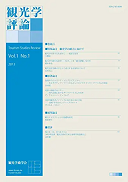Volume 8, Issue 1
Displaying 1-9 of 9 articles from this issue
- |<
- <
- 1
- >
- >|
-
2020Volume 8Issue 1 Pages 3-14
Published: 2020
Released on J-STAGE: October 29, 2022
Download PDF (988K) -
2020Volume 8Issue 1 Pages 15-26
Published: 2020
Released on J-STAGE: October 29, 2022
Download PDF (862K) -
2020Volume 8Issue 1 Pages 27-43
Published: 2020
Released on J-STAGE: October 29, 2022
Download PDF (936K) -
2020Volume 8Issue 1 Pages 45-53
Published: 2020
Released on J-STAGE: October 29, 2022
Download PDF (763K) -
2020Volume 8Issue 1 Pages 55-69
Published: 2020
Released on J-STAGE: October 29, 2022
Download PDF (871K) -
2020Volume 8Issue 1 Pages 71-83
Published: 2020
Released on J-STAGE: October 29, 2022
Download PDF (832K) -
2020Volume 8Issue 1 Pages 85-101
Published: 2020
Released on J-STAGE: October 29, 2022
Download PDF (1465K) -
2020Volume 8Issue 1 Pages 103-105
Published: 2020
Released on J-STAGE: October 29, 2022
Download PDF (608K) -
2020Volume 8Issue 1 Pages 107-109
Published: 2020
Released on J-STAGE: October 29, 2022
Download PDF (611K)
- |<
- <
- 1
- >
- >|
